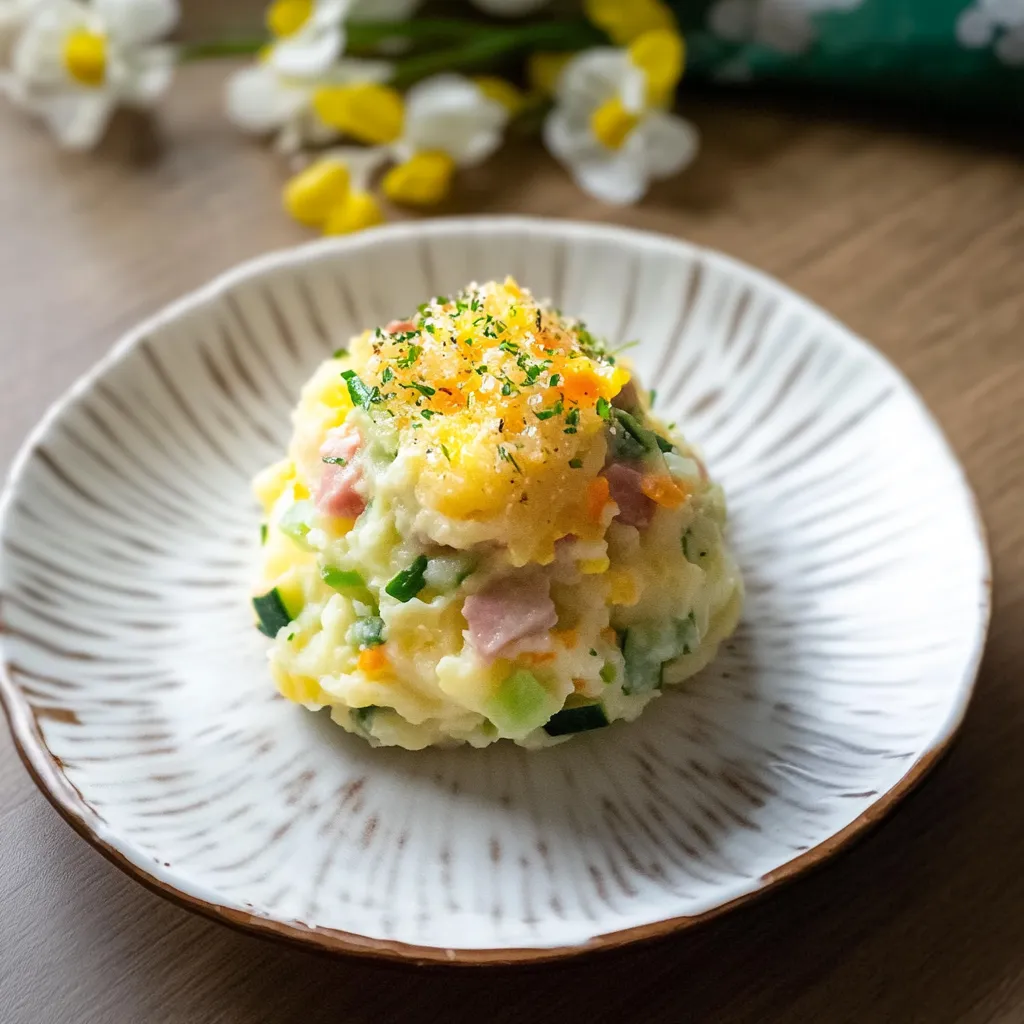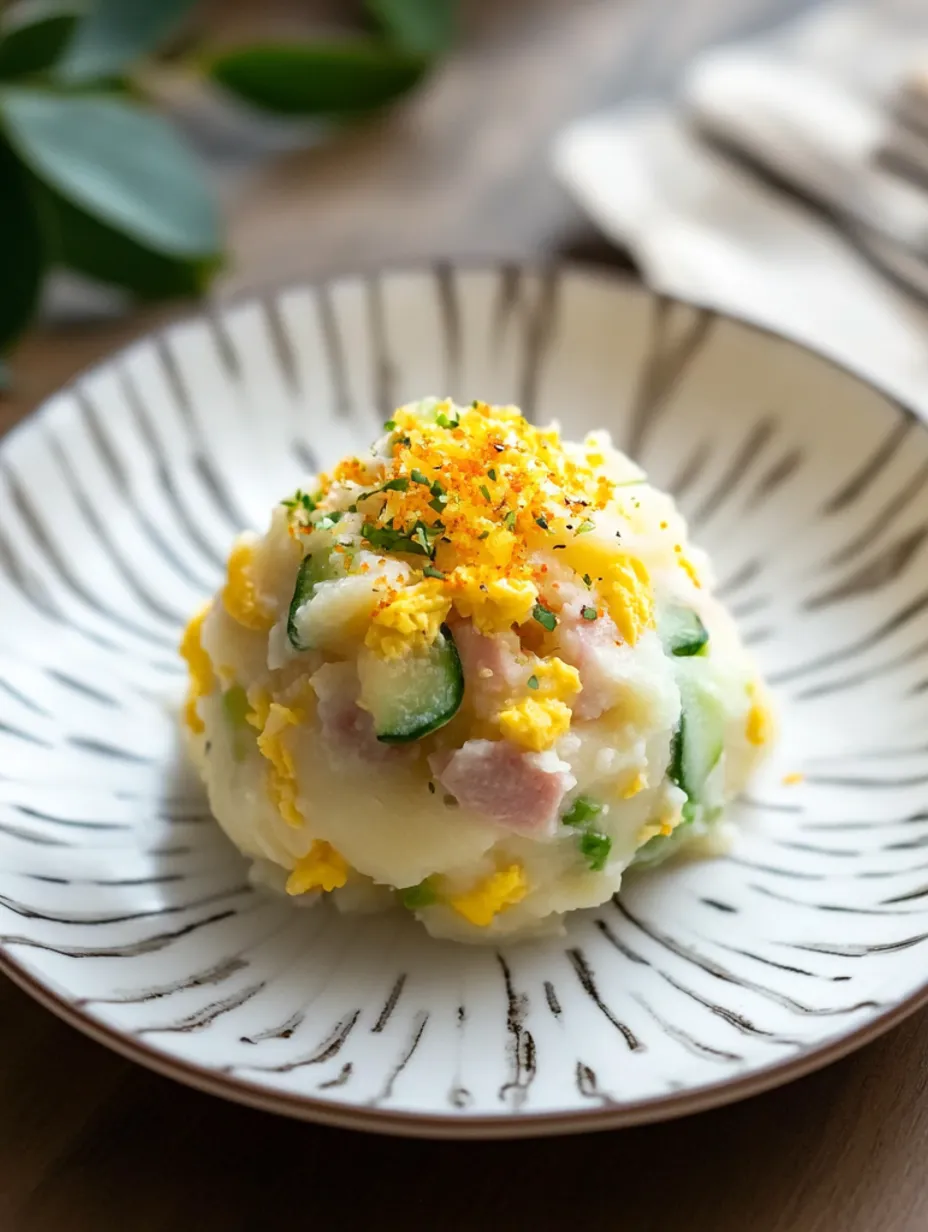 Pin it
Pin it
I fell in love with Gamja Salad long before Korean cuisine became trendy in my city. My first taste was at a tiny Korean BBQ spot where they served this creamy, fluffy potato salad as one of many banchan (side dishes) alongside sizzling meats. While the BBQ was delicious, it was this humble potato salad that I found myself thinking about days later. Something about the cloud-like texture studded with crunchy vegetables and that perfect balance of savory-sweet flavors just hit differently than any American potato salad I'd grown up with.
After multiple attempts to recreate it at home (and several phone calls to my Korean friend's mom for guidance), I finally nailed the texture and flavor profile. Now it's become one of my go-to side dishes when hosting, and friends constantly request "that amazing Korean potato thing" whenever I offer to bring something to gatherings.
The first time I made this for my boyfriend, he was skeptical about potato salad in general (bad memories of too-sweet, soggy versions at childhood picnics). One bite of this Gamja Salad and he was converted. Now he specifically requests it alongside any grilled meats or as a sandwich filling for his work lunches. If a potato salad can win over a potato salad hater, you know it's something special.
Simple Ingredients
Russet Potatoes - The foundation of our salad. I've tried this recipe with various potatoes, and russets truly give the best fluffy texture. Their higher starch content creates that perfect mashed consistency that's still substantial. Yukon Golds work well too if that's what you have on hand, though the result will be slightly more waxy and less cloud-like.
Hard-Boiled Eggs - These add richness and a velvety quality to the salad. The egg yolks incorporate into the mashed potatoes, making everything extra creamy. I usually boil an extra egg to use as a garnish - separating the white and yolk and grating them separately over the top creates that classic presentation you'll see in Korean restaurants.
Fresh Vegetables - The crunchy counterpoint to the soft potatoes. I typically use diced onion, carrot, and cucumber, but this is where you can get creative. The vegetables provide not just texture but little bursts of freshness that cut through the richness. I've tried it with diced apple, corn, and even peas with great results.
Ham - Adds a savory, slightly salty element. Nothing fancy needed here - just regular deli ham chopped into small pieces works perfectly. For variation, I sometimes substitute imitation crab (a very popular option in Korea), canned tuna, or even cooked bacon bits.
Mayonnaise - The binding agent that brings it all together. Regular mayonnaise works great and lets the other flavors shine. Some people prefer Japanese Kewpie mayonnaise for its richer egg flavor, but I find it can sometimes overpower the delicate balance, especially since we're already adding eggs to the mix.
Sugar - A touch to balance the savory flavors and enhance the sweetness of the potatoes and vegetables.
Salt and Pepper - To season the salad.
 Pin it
Pin it
Easy Preparation
Cook Your Potatoes ProperlyStart by peeling and cutting 2 pounds (about 900g) of russet potatoes into even, medium-sized chunks. Place them in a pot of cold water (starting with cold water helps them cook evenly), add a generous pinch of salt, and bring to a boil. Cook until the potatoes are very tender and easily pierced with a fork - about 15-20 minutes. You want them softer than you might for other potato recipes since we're going for that fluffy texture. While the potatoes cook, prepare an ice bath in a large bowl.
Perfect Hard-Boiled EggsWhile the potatoes are cooking, prepare your hard-boiled eggs. Place 3 eggs in a saucepan, cover with cold water by an inch, and bring to a boil. Once boiling, remove from heat, cover, and let sit for exactly 9 minutes. Transfer immediately to the ice bath to stop cooking. This method gives you perfectly cooked yolks that are set but still creamy, not chalky. Once cooled, peel the eggs and separate one egg for garnish if desired.
Prep Your Add-InsWhile everything is cooking, prepare your vegetables and ham. Finely dice about 1/4 cup of onion, 1/4 cup of carrot, and 1/2 cup of cucumber. For the cucumber, I recommend removing the seeds to prevent excess moisture in your salad. Dice about 1/4 cup of ham into small cubes. The key is cutting everything into similar-sized small pieces so you get a bit of each flavor in every bite.
Create That Perfect TextureOnce the potatoes are fork-tender, drain them thoroughly and return them to the hot pot. This helps evaporate any excess moisture. Use a potato masher to break them down - you want them well-mashed but not completely smooth like mashed potatoes. Some small lumps are part of the charm. Let them cool for about 10 minutes.
Mix It All TogetherChop two of the hard-boiled eggs into small pieces and add them to the mashed potatoes. Add your diced vegetables, ham, about 1/2 cup of mayonnaise, 1 teaspoon of sugar, 1/2 teaspoon of salt (or to taste), and freshly ground black pepper. Gently fold everything together until well combined. Be careful not to overmix or the potatoes can become gummy. Taste and adjust the seasonings as needed.
The Final TouchTransfer your potato salad to a serving bowl. If you're using the extra egg for garnish, grate the egg white using the fine side of a box grater and sprinkle it over one section of the salad. Do the same with the yolk over another section. This traditional presentation is not just for looks - it allows people to mix in extra egg if they prefer. Chill for at least an hour before serving to allow the flavors to develop.
I learned about the importance of potato type through trial and error. My first attempt used red potatoes because that's what I had on hand, and while the flavor was good, the texture was all wrong - too firm and waxy rather than fluffy and cloud-like. I also once made the mistake of not cooking the potatoes quite long enough, resulting in a chunkier texture that, while tasty, wasn't authentic to the Korean style. Now I make sure to cook the russets until they're very tender, and the result is that signature pillowy texture that makes Korean potato salad so special.
Serving Suggestions
While Gamja Salad is traditionally served as one of many side dishes alongside Korean BBQ, I've found it's incredibly versatile. It pairs beautifully with any grilled meats or fish, adding a creamy counterpoint to charred flavors. I particularly love it alongside spicy dishes as it helps cool the palate. But my absolute favorite way to enjoy this potato salad is as a sandwich filling. Spread between two slices of pillowy white bread (the softer, the better), it creates what I can only describe as a comfort food masterpiece. In Korea, these potato salad sandwiches are a popular grab-and-go item in cafes and bakeries, often cut into neat triangles with the crusts removed. I like to add a leaf of lettuce for extra crunch, but the potato salad is rich and flavorful enough to stand on its own. For an easy lunch spread, I sometimes serve the potato salad with an array of bread options, lettuce leaves, and some additional protein like sliced chicken or extra ham. Guests can create their own sandwiches or enjoy the salad on its own. Add a light soup, and you've got a perfect meal that feels special but requires minimal effort.
Creative Variations
While I love the classic version, this recipe welcomes personalization. For a fresher, more vibrant variation, try adding diced apple and corn kernels to the mix. The sweet crispness of the apple and the pop of the corn kernels add wonderful dimension to the salad. This version is particularly popular in modern Korean cafes. For a seafood twist, substitute the ham with imitation crab sticks torn into small pieces or even canned tuna drained well. The slight sweetness of crab sticks works beautifully with the creamy potatoes, while tuna adds a more savory note. If using tuna, I like to add a bit more mayonnaise as it tends to absorb more moisture. If you prefer a vegetarian version, simply omit the ham and consider adding more vegetables for texture and flavor. Diced bell peppers add a nice crunch and color, while corn and peas add sweetness. You could also add a sprinkle of furikake (Japanese seaweed and sesame seed seasoning) on top for an umami boost.
 Pin it
Pin it
Chef's Wisdom
Potato Pro Tip - After draining, return potatoes to the hot pot and allow them to steam dry for a minute before mashing for the best texture. Garnish Game-Changer - For an extra special presentation, use a fine mesh sieve to grate the egg yolk for the garnish - it creates a beautiful, powdery texture. Flavor Booster - Add a tiny splash of rice vinegar (just 1/2 teaspoon) to brighten all the flavors without making it noticeably tangy.
I've made this potato salad countless times now, and it's become one of those recipes I can prepare without even thinking. There's something deeply satisfying about transforming humble ingredients into something so delicious that people always ask for the recipe. While it might not be the most glamorous dish, there's a reason Korean potato salad has stood the test of time and continues to be a beloved banchan. It's comfort food at its finest – simple, satisfying, and somehow greater than the sum of its parts. Whether you serve it alongside a complex Korean feast or tucked into a simple sandwich, I promise it will bring a little moment of joy to whoever tries it.
Frequently Asked Questions
- → What's the difference between Korean potato salad and American potato salad?
- Korean potato salad (Gamja Salad) uses fully mashed potatoes rather than chunks, includes more vegetables, and has a smoother, creamier texture. It's also typically sweeter than American versions.
- → Can I make this potato salad ahead of time?
- Yes! It actually tastes better after the flavors have had time to meld. Make it up to 3-4 days ahead and store in an airtight container in the refrigerator.
- → What protein options can I use besides ham?
- Imitation crab, cooked tuna, or smoked salmon all work well as substitutes. You can also omit the protein entirely for a vegetarian version.
- → What kind of mayo works best for Korean potato salad?
- Japanese Kewpie mayonnaise is traditional and gives the authentic flavor, but any good quality mayonnaise will work well.
- → How is this typically served in Korea?
- Gamja salad is commonly served as a banchan (side dish) with Korean BBQ, in dosirak (lunch boxes), or as a filling in sandwiches, especially in street food sandwich shops.
